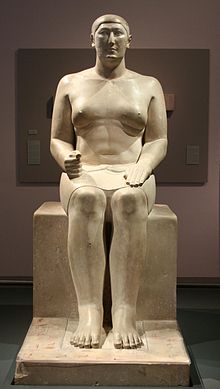Hemiunu
 From Wikipedia the free encyclopedia
From Wikipedia the free encyclopedia
| Hemiunu | |
|---|---|
| Hereditary Prince King's son of his body | |
 Statue of Hemiunu at the Pelizaeus Museum, Hildesheim, Germany, his feet rest on columns of hieroglyphs painted in yellow, red, brown, and black | |
| Egyptian name | Beloved royal son Hemiunu[1] |
| Dynasty | Fourth Dynasty of Egypt |
| Father | Nefermaat Vizier, keeper of the royal seal[2][3] |
| Mother | Itet |
Hemiunu (fl. 2570 BC) was an ancient Egyptian prince who is believed to have been the architect of the Great Pyramid of Giza.[4][5] As vizier, succeeding his father, Nefermaat, and his uncle, Kanefer,[6] Hemiunu was one of the most important members of the court and responsible for all the royal works. His tomb lies close to Khufu's pyramid.
Biography
[edit]Hemiunu was a son of prince Nefermaat and his wife, Itet.[7] He is a grandson of Sneferu and a nephew of Khufu, the Old Kingdom pharaoh. Hemiunu had three sisters and many brothers. In his tomb, he is described as a hereditary prince, count, sealer of the king of Lower Egypt (jrj-pat HAtj-a xtmw-bjtj), and on a statue found in his serdab (and now located in Hildesheim), Hemiunu is given the titles: king's son of his body, chief justice, and vizier, greatest of the five of the House of Thoth (sA nswt n XT=f tAjtj sAb TAtj wr djw pr-DHwtj).[8]


Tomb
[edit]Hemiunu's tomb lies close to Khufu's pyramid and contains reliefs of his image. Some stones of his badly damaged mastaba[11] are marked with dates referring to Khufu's reign.[12] His statue[13] can be found at the Pelizaeus Museum, Hildesheim, Germany.[7] His statue was found in the walled-up serdab of Hemiunu's mastaba by archaeologist Hermann Junker in March 1912. Ancient looters had ransacked the mastaba in their quest for valuable items and the wall to the serdab had a child-sized hole cut into it. The robber forcefully gouged out the statue's precious inlaid eyes and gold castings, in the process the right arm was broken and the head severed. The head has been restored,[14] using a relief of Hemiunu as a guide for the nose's profile.
The seated statue is well-preserved, apart from the damage mentioned above (importantly, his head being severed), and is notable for its realism, not found in ancient Egyptian art depicting royal figures. Hemiunu's features are only lightly stylized and clearly based on his appearance. He is depicted as obese, with notable accumulation of fat in the pectoral region. This contrasts with the more idealized representation of male subjects in royal portraiture in this and most succeeding periods of ancient Egyptian art.
Notes
[edit]- ^ Junker p.151
- ^ Petrie p.93
- ^ a b Grajetzky
- ^ De Camp, p. 35
- ^ Shaw, p. 89
- ^ Cambridge, p. 166
- ^ a b Arnold, p. 107
- ^ "Hemiunu (G 4000)". Hemiunu, owner of G 4000
- ^ Junker p. 146
- ^ Baud p. 516
- ^ "G 4000".Mastaba G 4000 Western Cementery
- ^ Strudwick, p. 157
- ^ Tiradritti, p. 13
- ^ N.Y.), Metropolitan Museum of Art (New York (1999). Egyptian Art in the Age of the Pyramids. Metropolitan Museum of Art. ISBN 9780870999079.
References
[edit]- Hermann Junker, Gíza I. Grabungen auf dem Friedhof des Alten Reiches bei den Pyramiden von Giza, Tom. I, Hölder-Pichler-Tempsky, Wien 1929
- Michael Baud, Famille royale et pouvoir sous l’Ancient Epirem égyptien Tom.1, Institute Français D’Archologie Oriental, Caire 1999
- Grajetzky Wolfram, Who was Nefermaat?, University College London 2003,[1]
- Flinders Petrie, Medum, David Nutt, London 1892 [2]
- Dieter Arnold, The Encyclopaedia of Ancient Egyptian Architecture, I.B.Tauris, 2002
- Nigel C. Strudwick, Texts from the Pyramid, SBL, 2005
- Cambridge Ancient History by Cambridge University Press, 2000
- Francesco Tiradritti, Arte egizia, Giunti, 2002
- Lyon Sprague De Camp, Catherine Crook De Camp, Ancient Ruins and Archaeology, Doubleday, 1964
- Ian Shaw, The Oxford History of Ancient Egypt, Oxford University Press, 2003
See also
[edit] Media related to Hemiunu at Wikimedia Commons
Media related to Hemiunu at Wikimedia Commons